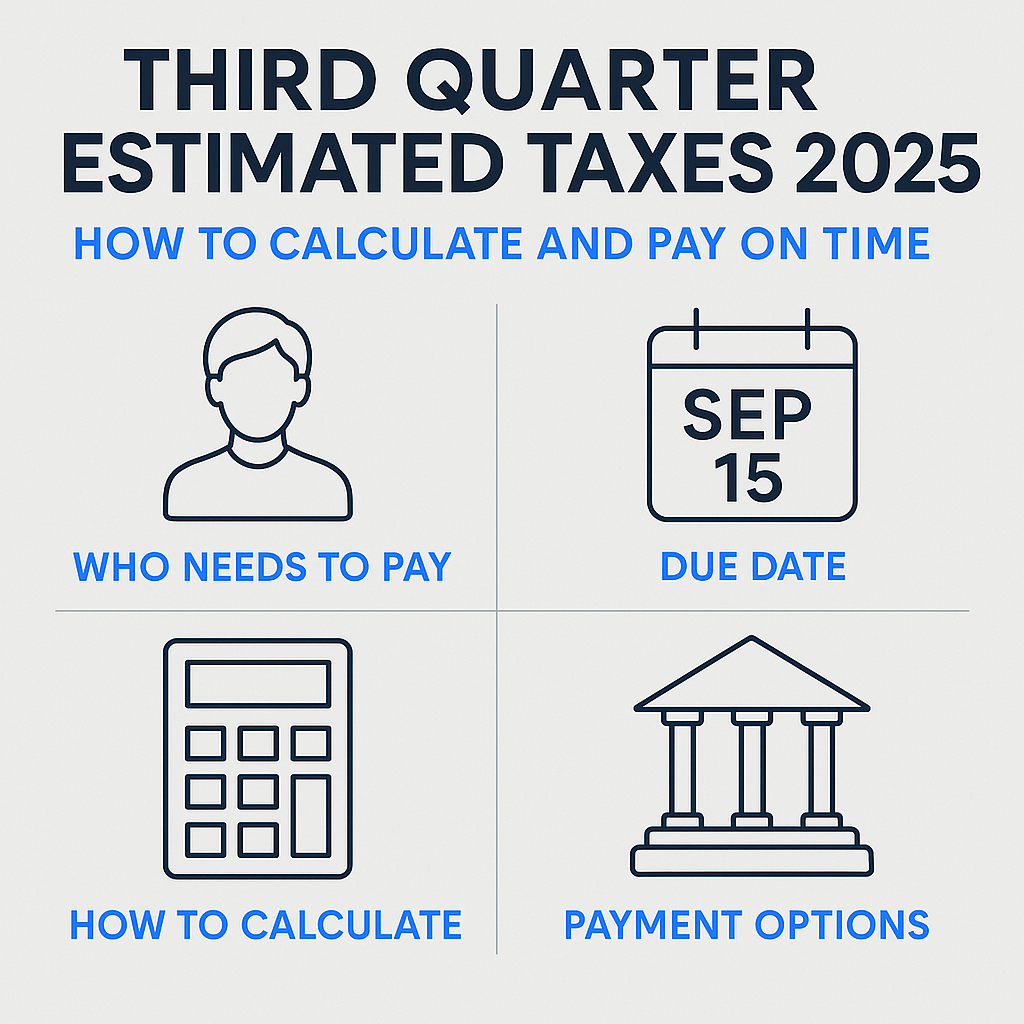
Key facts about third quarter estimated taxes in 2025: who needs to pay, the due date, how to calculate, and payment options.
Third Quarter Estimated Taxes 2025: How to Calculate and Pay on Time
If you’re self-employed, run a side hustle, or operate a small business, the third quarter estimated taxes 2025 deadline is approaching fast. Failing to pay Q3 estimated taxes correctly can lead to IRS underpayment penalties and cash flow headaches. This guide explains who must pay, how to calculate 2025 estimated taxes, and the best ways to submit your payment.
Who Needs to Pay Q3 Estimated Taxes in 2025?
You need to make Q3 estimated tax payments if you expect to owe at least $1,000 in federal tax for 2025 after subtracting withholding and refundable credits. This includes:
- Self-employed professionals and freelancers
- Side hustle operators with net income
- Small business owners filing as sole proprietors, LLCs, or S corps
- Investors with significant capital gains or dividend income
Need help tracking side hustle income? Check our guide on 3 Simple Ways to Track Side Hustle Income Without Stress.
When Are Third Quarter Estimated Taxes Due in 2025?
The IRS requires that third quarter estimated taxes for 2025 be paid by September 15, 2025. Missing the quarterly tax deadline triggers interest and penalties, even if you pay in full when you file your annual return.
If you’re thinking of delaying, you might be interested in Offer in Compromise vs. Installment Agreement—and whether an OIC makes sense for you.
How to Calculate Estimated Taxes for Q3 2025
Calculating your estimated tax payment correctly avoids penalties and overpayment. The IRS provides Form 1040-ES, but here’s a breakdown:
- Estimate your total income for 2025.
- Apply the correct tax rate for self-employment, ordinary income, and capital gains.
- Subtract credits and withholding.
- Divide by four for quarterly payments, adjusting for amounts already paid in Q1 and Q2.
For side hustlers and freelancers, particularly, we recommend our Side Hustle Tax Guide—it includes worksheets, calculators, and real-world examples.
IRS Payment Options for 2025 Estimated Taxes
The IRS offers several secure methods to pay your estimated tax payments for Q3 2025:
- IRS Direct Pay – free, direct from your bank account.
- EFTPS – best for recurring business payments.
- Credit/debit card – convenient, though fees apply.
- Mail with voucher – slowest and least secure option.
Want a comprehensive breakdown of each method? Stay tuned for our post on IRS Online Payment Options in 2025.
Common Mistakes With Estimated Taxes 2025
Don’t fall into these common traps:
- Using outdated income projections
- Forgetting to adjust for deductions or credits
- Missing the quarterly tax deadline
- Paying by mail and facing delays
If you’re already dealing with unpaid taxes, our free Offer in Compromise Checklist can help you evaluate your options quickly.
How to Avoid Penalties on Estimated Taxes 2025
The IRS safe harbor is your ally—meet it by paying the lesser of:
- 90% of your 2025 total tax liability, or
- 100% of your 2024 tax liability (110% if AGI > $150,000).
If you primarily work from home or run a home-based business, our Home Office Toolkit offers tools and calculators to help you optimize your deductions.
Final Thoughts on Q3 Estimated Taxes 2025
Preparing your third quarter estimated taxes accurately by September 15, 2025, is essential for avoiding penalties. Mark the date, calculate wisely, and use the right IRS payment method to stay compliant.
Need even more guidance? Grab the Side Hustle Tax Guide—packed with worksheets, checklists, and bonus content to keep you penalty-free.
Disclaimer
Disclaimer: The information provided in this blog post is for informational purposes only and should not be construed as legal, tax, or accounting advice. Tax situations are often complex and highly specific to the individual or business. You should contact a qualified tax expert directly to discuss your particular circumstances. Nothing herein is intended to, nor does it, create an attorney-client or advisor-client relationship. For individual guidance, please contact us directly.
Additional Posts
- 7 Key Facts About Disaster Tax Relief After Severe Weather
- 7 Smart Ways to Maximize the Home Office Deduction in 2025
- 5 Shocking Facts About IRS Passport Revocation for Tax Debt
- Offer in Compromise vs. Installment Agreement: 5 Key Differences in IRS Payment Plans
- 3 Simple Ways to Track Side Hustle Income Without Stress


